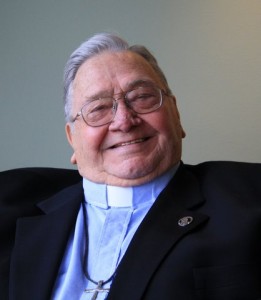Paul focussed life on Christ
By the Rev. Canon Don Beatty
 Before we look at Paul’s second missionary journey and the beginning of his correspondence, we need to look at the man himself. He was born to religious Jewish parents and brought up in Tarsus, on the southwest coast of Turkey. He was at home in Greco-Roman philosophy, religion and rhetoric. He also seemed to have enjoyed the privileges of Roman citizenship. According to Luke, he was educated by Gamaliel, an important rabbi of the first century, and his letters show distinctly Palestinian Jewish concerns.
Before we look at Paul’s second missionary journey and the beginning of his correspondence, we need to look at the man himself. He was born to religious Jewish parents and brought up in Tarsus, on the southwest coast of Turkey. He was at home in Greco-Roman philosophy, religion and rhetoric. He also seemed to have enjoyed the privileges of Roman citizenship. According to Luke, he was educated by Gamaliel, an important rabbi of the first century, and his letters show distinctly Palestinian Jewish concerns.
Paul was loyal to the Torah as practiced by the Pharisees. He was familiar with the Hebrew Bible but used the Greek translation of the scriptures, called the Septuagint. He believed that Jesus was the Jewish Messiah and always went first to the synagogues to proclaim his message. He believed that a Jew must be obedient to the Torah; thus, when Timothy joined the team, Paul circumcised him, as Timothy’s mother was Jewish. Titus was not circumcised, despite the protests of the Judaizers, because he was not born a Jew. The Gentile converts only had to follow the dictates of the Council of Jerusalem (see my column last month).
Paul had a dramatic religious conversion. He was persecuting the church, for he believed that Jesus was cursed by God because he had been hanged upon a tree (Deuteronomy 21:23). On the road to Damascus, Paul was confronted by the risen Christ, an experience that changed the course of his life. He had been on the fast-track to become a Jewish rabbi; now he would be branded a heretic by his Jewish friends.
Paul’s letters were not theological, except the Epistle to the Romans, which we will discuss when we reach that period of his life. His other letters were primarily pastoral. We need to remember that we only possess one side of the discussion. Paul’s letters were usually answering questions or concerns that arose in the local Christian communities.
Paul was a Jew throughout his life. After his conversion, he focussed his life on the risen Christ and the importance of life “in Christ.” He believed that the new age of God began with the resurrection of Jesus. Jesus was the new Adam – a new creation. His missions were grounded in Jesus’s resurrection as the Lord of all humanity, for the Jew first and then for the Gentile.
We possess 13 epistles in the Christian Bible credited to Paul. Very early in church history, the Epistle to the Hebrews was considered to be non-Pauline in authorship. I think there could have been many other letters lost in antiquity. The amazing thing is that the churches kept these letters written by Paul and eventually copied and shared them with other Christian communities.
Now let us move on to his second journey. After Paul and Barnabas returned to Antioch from their first missionary journey, they went to Jerusalem to plead for the Gentile converts. Silas accompanied them back to Antioch to help them interpret the findings of the Council of Jerusalem to the Gentile converts. Paul and Barnabas then decided to revisit the Gentile communities from the first trip. Barnabas wanted to take John Mark but Paul refused, as Mark had deserted them on the first trip. This led to a falling out between Paul and Barnabas; they were never reconciled in scripture, although Paul and Mark were (see Colossians 4:10 and 2 Timothy 4:11). I often wonder what would have happened if Paul and Barnabas had remained together. They were a good team and their split was unfortunate. We will never know what they may have accomplished together.
Barnabas took Mark with him to Cyprus and we hear no more about his ministry. Paul invited Silas to accompany him on this second trip, and together they set out to visit all the communities that had been established on the first journey. They strengthened the communities and helped them stand up against the Judaizers, who still insisted that Gentile converts must be circumcised.
Acts 16 has Paul’s mission team in Derbe and Lystra, where they meet Timothy. He became like a son to Paul and is mentioned in a number of epistles. Luke tells us in Acts 16:5 that the mission churches were strengthened in their faith and grew daily. As the group moved through Troas, Luke joined them. In Acts 16:10, we see the beginning of the “we” passages. Luke was present and giving us a first-hand account of the mission. With one brief interlude, the “we” passages continue to the end of Acts.
In the next issue, we will look at Paul’s first and second letters, 1 and 2 Thessalonians, and the beginning of his writings. Enjoy the dialogue.
The Rev. Canon Don Beatty is an honorary assistant at St. Luke, Dixie South, Mississauga.